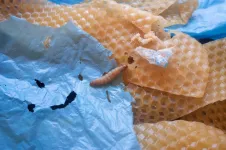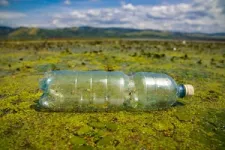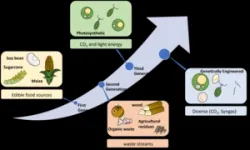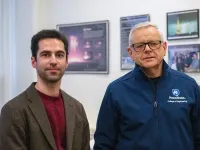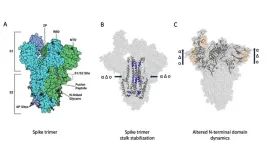(Press-News.org) As Earth’s population grows, the demands of modern lifestyles place mounting strain on the global environment. Proposed solutions to preserve and promote planetary sustainability can sometimes prove more harmful than helpful. However, technologies that harness natural processes could be more successful.
Such technologies are the focus of the latest issue of the open access journal PLOS Biology, which features a special collection publishing March 31st of papers highlighting biology-based solutions that could be applied to reduce carbon dioxide emissions, eliminate non-degradable plastics, produce food or energy more sustainably, and more.
In one of the papers, Federica Bertocchini and Clemente Arias of the Spanish Natural Research Council outline recent research supporting the possibility of using insects to degrade plastic waste, specifically polyethylene. This insect enzyme could serve as a more sustainable alternative to current methods of incineration and mechanical recycling.
Bertocchini adds, “Plastic biodegradation: the technology is not quite there yet, but insect enzymes may represent the tipping point in the field.”
In another plastics-focused article, Sandra Pascoe Ortiz of Universidad del Valle de Atemajac, Mexico, examines ongoing initiatives to develop fully recyclable bioplastics—a broad category of materials that are either made from renewable sources and may or may not be biodegradable, or are made from fossil sources but are biodegradable. Pascoe Ortiz reveals that these initiatives, while promising, are still far from completely solving the problem of plastic pollution.
Pascoe Ortiz adds, “Plastic pollution is a serious problem that needs to be addressed, there are some materials that can help to solve it, but the most important thing is to be aware of the use and disposal we give to different products regardless of the material.”
Turning to the challenge of carbon dioxide pollution, Peter Ralph and Mathieu Pernice of the University of Technology Sydney, Australia describe the potential of using photosynthetic algae to capture carbon dioxide produced as a byproduct of a wide variety of industrial applications, keeping the greenhouse gas out of the atmosphere. The researchers have already put this approach into practice by collaborating with a brewery.
Ralph adds, “Algae-based carbon capture and manufacture (CCM) has great potential to help mitigate climate change by capturing atmospheric carbon and using it to create long-lasting bioproducts to store carbon. Additionally, CCM offers numerous industrial benefits, such as reducing the cost of chemical processes and enabling the use of advanced manufacturing, potentially transforming many industries into climate-positive biomanufacturing.”
Thomas Brück’s research group (Werner Siemens Chair of Synthetic Biotechnology) at the Technical University of Munich, Germany summarizes the current state of available biofuel technologies. Advanced biofuels are sustainable “drop-in” alternatives to fossil equivalents and complement other renewable energy resources, thereby eliminating CO2 emissions. The researchers outline a definitive set of policy recommendations for rapid global deployment of these technologies.
Brück adds, “Advanced biofuels do not compete with agriculture and can be realized via greenhouse gas neutral or even negative processes today. These can contribute to energy security and sustainable mobility but require a stable legislative framework together with financial incentives for broad industrial roll out and applicability.”
Along with the other articles in the collection, these perspectives could help inform and guide policies and further initiatives to keep Earth green.
#####
The full Collection is available in PLOS Biology here: https://collections.plos.org/collection/going-for-green-biology-for-planetary-sustainability/
In your coverage, please use this URL to provide access to the freely available papers in PLOS Biology:
https://journals.plos.org/plosbiology/article?id=10.1371/journal.pbio.3001979
https://journals.plos.org/plosbiology/article?id=10.1371/journal.pbio.3002045
https://journals.plos.org/plosbiology/article?id=10.1371/journal.pbio.3002061
https://journals.plos.org/plosbiology/article?id=10.1371/journal.pbio.3002063
END
Can an individual’s social status have an impact on their level of stress? Researchers at Tulane University put that question to the test and believe that social rank, particularly in females, does indeed affect the stress response.
In a study published in Current Biology, Tulane psychology professor Jonathan Fadok, PhD, and postdoctoral researcher Lydia Smith-Osborne looked at two forms of psychosocial stress — social isolation and social instability — and how they manifest themselves based on social rank.
They conducted their research on adult female mice, putting them in pairs and allowing them to form a stable ...
Long thought of as “brain glue,” the star-shaped cells called astrocytes—members of a family of cells found in the central nervous system called glial that help regulate blood flow, synaptic activity, keep neurons healthy, and play an important role in breathing. Despite this growing appreciation for astrocytes, much remains unknown about the role these cells play in helping neurons and the brain process information.
“We believe astrocytes can add a new dimension to our understanding of how external and internal information is merged in the ...
On Friday March 31st, 2023 at a ceremony in Paris, the Institut Pasteur President, Professor Stewart Cole, and the University of São Paulo (USP) Rector, Carlos Gilberto Carlotti Junior, signed articles of association for the Institut Pasteur in São Paulo, a private non-profit organization under Brazilian law. The mission of the institute, an associate member of the Pasteur Network, is to conduct research in the field of biology that contributes to the development of human health, and to promote outreach, education, innovation and knowledge transfer activities and public health measures.
The Institut Pasteur ...
UNIVERSITY PARK, Pa. — In the early 2000s, scientists observed lightning discharge producing X-rays comprising high energy photons — the same type used for medical imaging. Researchers could recreate this phenomenon in the lab, but they could not fully explain how and why lightning produced X-rays. Now, two decades later, a Penn State-led team has discovered a new physical mechanism explaining naturally occurring X-rays associated with lightning activity in the Earth’s atmosphere.
They published their ...
East Hanover, NJ – March 31, 2023 – Since the pandemic, gains in the labor market have been slower to materialize for black/African American people with disabilities compared to their white counterparts, according to experts speaking last Friday during the nTIDE Deeper Dive Lunch & Learn Webinar. They discussed potential factors underlying why the disability employment gap is wider among members of the black/African American population when compared to the white population and how to integrate measures to effect change.
Using data from the U.S. Bureau of Labor Statistics (BLS) for persons ages 16-64, the monthly employment-to-population ratio averaged ...
Antibiotic resistance is a global health threat. In 2019 alone, an estimated 1.3 million deaths were attributed to antibiotic resistant bacterial infections worldwide. Looking to contribute a solution to this growing problem, researchers at Baylor College of Medicine have been studying the process that drives antibiotic resistance at the molecular level.
They report in the journal Molecular Cell crucial and surprising first steps that promote resistance to ciprofloxacin, or cipro for short, one of the most commonly prescribed antibiotics. The findings point at potential ...
HUNTINGTON, W.Va. – A new study led by Marshall University researchers focuses on a novel mechanism of the body’s regulation of salt balance.
The kidney plays a central role in the body’s ability to maintain an appropriate sodium balance, which is critical for the determination of blood pressure. Disorders of sodium balance contribute to the development and progression of many common diseases, including hypertension, heart disease and stroke.
Na/K-ATPase (NKA) is the enzymatic machinery that drives absorption of sodium along the renal proximal tubule. As ...
UNIVERSITY PARK, Pa. — Just as a tight core is a component of good physical fitness for humans, helping to stabilize our bodies, mutations that tightened the core of the SARS-CoV-2 spike protein in new variants may have increased the virus’s fitness.
New research led by Penn State reveals that the stem region of the spike protein became progressively tighter over time, and the team thinks this likely improved the virus’s ability to transmit through nasal droplets and infect host cells once in the body. The team said the stem region of the protein that emerged in the most recent Omicron variants is as rigid as it can get, which could ...
A rare and nevertheless formidable event in the landscape of epilepsies, New-Onset Refractory Status Epilepticus (NORSE) is a form of prolonged seizure in which the neurons of the epileptic focus endure a continuous discharge of neurotransmitters. It is a medical emergency requiring intensive care management. Indeed, it can cause significant long-term neurological sequelae and is associated with an average mortality rate of 12% in children and 16 to 27% in adults. NORSE can occur in response to an infection or tumor development. However, its origin remains unknown in half of the affected patients despite extensive clinical and biological ...
The human body contains more than 30 trillion cells. Until recently, the sheer number of cells in the organism meant that approaches to understanding human diseases and developmental processes based on the analysis of single cells were a futuristic vision. The development of new sequencing methods is currently revolutionising our understanding of cellular heterogeneity. These technologies can detect rare or even new cell types by extracting and sequencing the genetic information from the cells based on ribonucleic acid chains.
In cooperation ...
